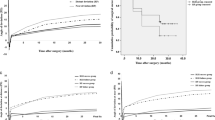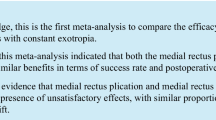Abstract
Objective
To compare the outcomes between bilateral lateral rectus recession (BLR) and unilateral recession resection (R&R) procedures in the treatment of basic intermittent exotropia.
Methods
Databases from Medline, Embase, Web of Science and the Cochrane Register of Controlled Trials were searched prior to June 2, 2017. From these searches, three eligible randomized studies and three retrospective cohort trials, which compared conventional BLR versus R&R procedure were identified. Differences observed between these two interventions (BLR versus R&R) were expressed as odds ratio (OR) and 95% confidence intervals (CI). The data on rates of success, recurrence, and overcorrection were pooled and analyzed using a random-effects model.
Results
Our findings, as generated from the pooled estimates, suggested that success rates for the R&R procedure were significantly greater than that of BLR (OR, 0.50; 95% CI, 0.31–0.79; P = 0.003) and patients subjected to the BLR procedure were more likely to be recurrent (OR, 2.44; 95% CI, 1.17–5.10; P = 0.02). No statistically significant differences in the combined results for overcorrection rates were present between the BLR and R&R procedures (OR, 0.85; 95% CI, 0.32–2.28; P = 0.75).
Conclusion
The overall findings from this meta-analysis indicated that the conventional R&R procedure is associated with higher success rates and lower recurrence rates in patients with basic intermittent exotropia.




Similar content being viewed by others
References
Govindan M, Mohney BG, Diehl NN et al (2005) Incidence and types of childhood exotropia: a population-based study. Ophthalmology 112(1):104–108
Mohney BG, Huffaker RK (2003) Common forms of childhood exotropia. Ophthalmology 110(11):2093–2096
Clark M (2007) Intermittent exotropia. J Pediatr Ophthalmol Strabismus 44:153–157
Burian HM, Spivey BE (1965) The surgical management of exodeviations. Am J Ophthalmol 59:603
Burian HM (1966) Exodeviations: their classification, diagnosis and treatment. Am J Ophthalmol 62:1161–1166
Kushner BJ (1998) Selective surgery for intermittent exotropia based on distance/near differences. Arch Ophthalmol 116:324–328
von Noorden GK, Campos EC (2002) Binocular vision and ocular motility: theory and management of strabismus, 6th edn. Mosby, Inc, St Louis, Missouri, pp 356–376
Burian HM, Spivey BE (1964) The surgical management of exodeviations. Trans Am Ophthalmol Soc 62:276–305
Burian HM, Franceschetti AT (1970) Evaluation of diagnostic methods for the classification of exodeviations. Trans Am Ophthalmol Soc 68:56–71
Jeoung JW, Lee MJ, Hwang J-M et al (2006) Bilateral lateral rectus recession versus unilateral recess-resect procedure for exotropia with a dominant eye. Am J Ophthalmol 141:683–688
Somer D, Demirci S, Cinar F et al (2007) Accommodative ability in exotropia: predictive value of surgical success. J AAPOS 11:460–464
Zhang M, Lu S, Liu H et al (2011) Comparison of surgical outcomes of intermittent exotropia with different surgery. Chin J Pract Ophthalmol 29(4):396–398
Wang L, Wu Q, Kong X et al (2013) Comparison of bilateral lateral rectus recession and unilateral recession resection for basic type intermittent exotropia in children. Br J Ophthalmol 97:870–873
Choi J, Chang JW, Kim SJ et al (2012) The long-term survival analysis of bilateral lateral rectus recession versus unilateral recession-resection for intermittent exotropia. Am J Ophthalmol 153(2):343–351
Fiorelli VM, Goldchmit M, Uesugui CF et al (2007) Intermittent exotropia: comparative surgical results of lateral recti-recession and monocular recess-resect. Arq Bras Oftalmol 70(3):429–432
Lee S, Lee YC (2001) Relationship between motor alignment at postoperative day 1 and at year 1 after symmetric and asymmetric surgery in intermittent exotropia. Jpn J Ophthalmol 45(2):167–171
Yuksel D, Spiritus M, Vandelannoitte S (1998) Symmetric or asymmetric surgery for basic intermittent exotropia. Bull Soc Belge Ophtalmol 268:195–199
Higgins JPT, Altman DG, Sterne JAC (editors) (2011) Chapter 8: assessing risk of bias in included studies. In: Higgins JPT, Green S (editors). Cochrane Handbook for Systematic Reviews of Interventions. Version 5.1.0 (updated March 2011). The Cochrane Collaboration. Available from handbook-5-1.cochrane.org. Accessed 15 June 2017
Critical Appraisal Skills Programme (CASP) (2010) Making sense of evidence about clinical effectiveness. Cohort appraisal checklist http://www.casp-uk.net/wp-content/uploads/2011/11/CASP_Cohort_Appraisal_Checklist_14oct10.pdf (accessed 7 Feb 2013)
Kamal AM, Abdelhakeem AS, Elhilaly HM (2008) Comparative study between bilateral lateral rectus recession and unilateral recess-resect surgery in management of basic exotropia. J AAPOS 12:e7–e8
Rajavi Z, Moezzi GH, Hamidi S (2001) The results of bilateral rectus (blr) recession and unilateral recess and resect (r&r) on basic exotropia. Am Acad Ophthalmol 227
Chia A, Seenyen L, Long QB (2006) Surgical experiences with two-muscle surgery for the treatment of intermittent exotropia. J AAPOS 10(3):206–211
Joyce KE, Beyer F, Thomson RG et al (2015) A systematic review of the effectiveness of treatments in altering the natural history of intermittent exotropia. Br J Ophthalmol 99(4):440–450
Chiu A, Din N, Ali N (2014) Standardising reported outcomes of surgery for intermittent exotropia—a systematic literature review. Strabismus 22(1):32–36
Contributors
YS and JC conceived the study. YS and JC designed and performed the searches. YS and TZ conducted data extraction, appraisal, and synthesis. YS and JC wrote the manuscript. All authors participated in discussions about eligibility and quality of the included studies, critically reviewed and approved the final version of the manuscript.
Funding
Supported by grants from Guangdong Provincial Scientific Technological Research Fund, China (no. 2014A020209031). The sponsor had no role in the design or conduct of this research.
Author information
Authors and Affiliations
Corresponding author
Ethics declarations
Conflict of interest
The authors declare that they have no conflict of interest.
Ethical approval
For this type of study formal consent is not required.
Informed consent
This article does not contain any studies with human participants performed by any of the authors.
Rights and permissions
About this article
Cite this article
Sun, Y., Zhang, T. & Chen, J. Bilateral lateral rectus recession versus unilateral recession resection for basic intermittent exotropia: a meta-analysis. Graefes Arch Clin Exp Ophthalmol 256, 451–458 (2018). https://doi.org/10.1007/s00417-018-3912-1
Received:
Revised:
Accepted:
Published:
Issue Date:
DOI: https://doi.org/10.1007/s00417-018-3912-1




